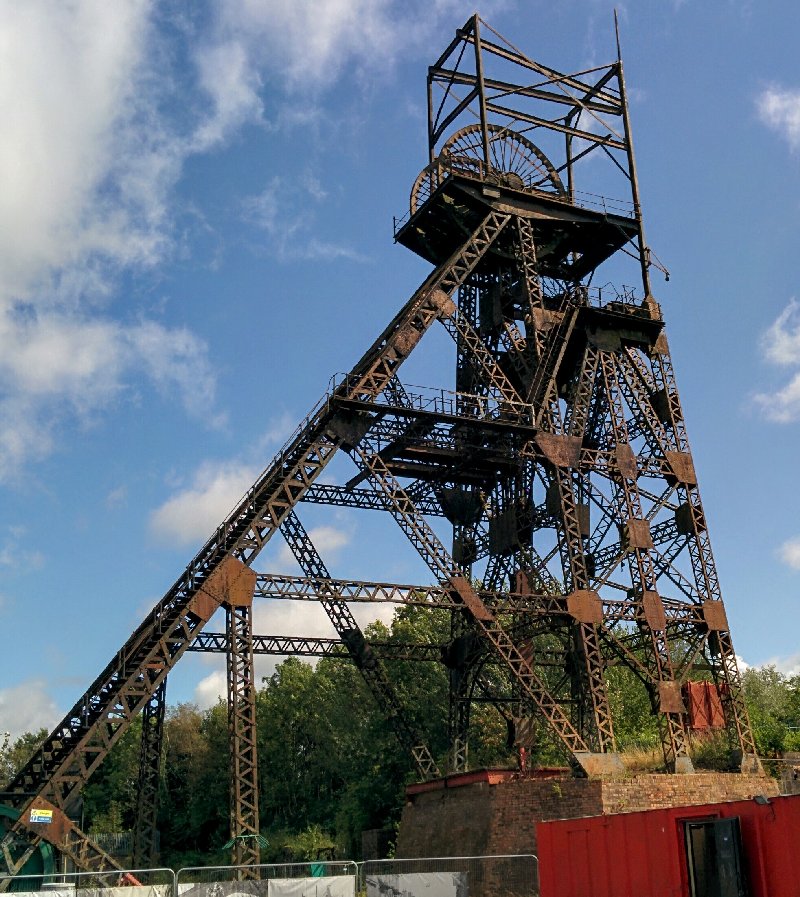Good turnout for this hastily arranged trip i.e. 11 of us altogether (we weren’t going to have one this year because of the virus but, now as the restrictions have been lifted, it seemed like a good opportunity to visit this highly rated museum that’s right on our doorstep). The Museum is on the site of Astley Green Colliery which closed in 1970 leaving the only intact mining head gear left in Lancashire. It started life in 1908 when a high demand for coal prompted the digging of deep shafts to exploit the coal reserves stretching out under the Chat Moss. However it wasn’t the head gear that saved the site from demolition but the magnificent 3,300 hp twin tandem compound steam winding engine. It’s the largest still working engine in Europe – possibly the world (the Trencherfield Mill engine is a mere 2500 hp) and, thanks to the Red Rose Steam Society, is run at regular intervals throughout the year.
The Museum is on the site of Astley Green Colliery which closed in 1970 leaving the only intact mining head gear left in Lancashire. It started life in 1908 when a high demand for coal prompted the digging of deep shafts to exploit the coal reserves stretching out under the Chat Moss. However it wasn’t the head gear that saved the site from demolition but the magnificent 3,300 hp twin tandem compound steam winding engine. It’s the largest still working engine in Europe – possibly the world (the Trencherfield Mill engine is a mere 2500 hp) and, thanks to the Red Rose Steam Society, is run at regular intervals throughout the year.  Our visit started with an entertaining talk by Steve Eckersley the site director who explain the history of the site and how it was saved form destruction to become the museum it is today. We were then let loose to explore the towering winding house with its splendid engine. On hand were volunteers to explain its workings such as the unusual valve gear. What was particularly interesting was the valve gear, most steam engines have sliding valves but this has rotary valves, four to each cylinder (which is reminiscent of the the earliest locomotives such as Blenkinsop’s and Daglish’s engines). The reversing mechanism though was the traditional Stephenson’s eccentrics (what Harold is looking at in the photo). The engine drives the enormous winding drum at 58 rpm which was capable of lifting 15 tons of coal from 2000 feet in less than a minute.
Our visit started with an entertaining talk by Steve Eckersley the site director who explain the history of the site and how it was saved form destruction to become the museum it is today. We were then let loose to explore the towering winding house with its splendid engine. On hand were volunteers to explain its workings such as the unusual valve gear. What was particularly interesting was the valve gear, most steam engines have sliding valves but this has rotary valves, four to each cylinder (which is reminiscent of the the earliest locomotives such as Blenkinsop’s and Daglish’s engines). The reversing mechanism though was the traditional Stephenson’s eccentrics (what Harold is looking at in the photo). The engine drives the enormous winding drum at 58 rpm which was capable of lifting 15 tons of coal from 2000 feet in less than a minute.  At the foot of the head gear are a number buildings which in include a display of mining memorabilia. Scattered about outside are numerous examples of steam engines of various sizes and even a coal cutter. They also have a number of underground locomotives and on certain days you can travel round the grounds on a steam powered train.
At the foot of the head gear are a number buildings which in include a display of mining memorabilia. Scattered about outside are numerous examples of steam engines of various sizes and even a coal cutter. They also have a number of underground locomotives and on certain days you can travel round the grounds on a steam powered train.  Steve mentioned that his unpaid volunteers have worked hard over the years to breath new life into the site, however there is still much to do. The headgear alone is likely to cost in the region of 1 million pounds to restore and preserve it. So, although the museum is free, the museum trustees are welcome to any donation people can make. And I most say none of the money they receive is wasted as they are doing a great job, collecting, storing and preserving Lancashire’s mining heritage.
Steve mentioned that his unpaid volunteers have worked hard over the years to breath new life into the site, however there is still much to do. The headgear alone is likely to cost in the region of 1 million pounds to restore and preserve it. So, although the museum is free, the museum trustees are welcome to any donation people can make. And I most say none of the money they receive is wasted as they are doing a great job, collecting, storing and preserving Lancashire’s mining heritage.
The Wigan Archaeological Society
Project Blog
